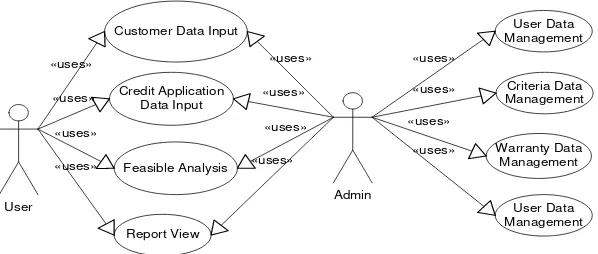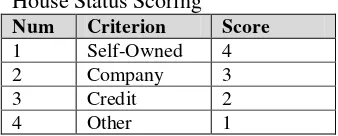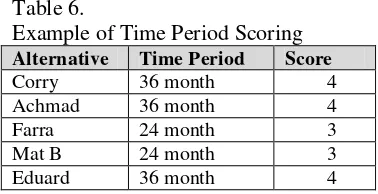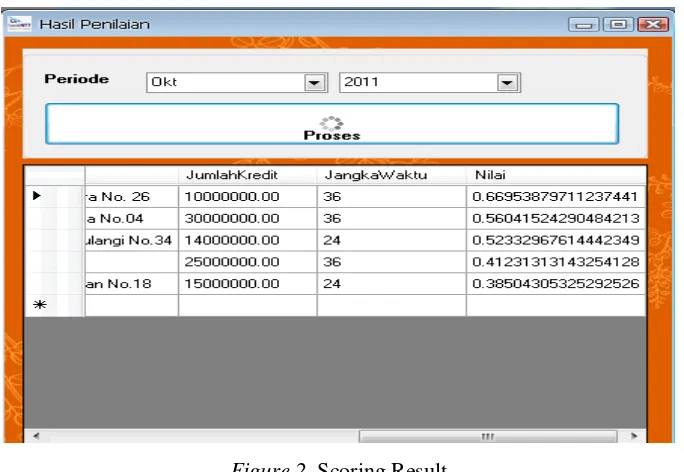1
DECISION SUPPORT SYSTEM TO SELECT CANDIDATES FOR
LOAN USING TOPSIS
Andeka Rocky Tanaamah (1)
Jasson Prestiliano
(2)Elvin Djami(3)
atanaamah@staff.uksw.edu
jasprelao@yahoo.com
epinxtho@yahoo.com
Abstract
Noticing the development of technology is developing rapidly increasing, companies need information systems that can support decision-making requirement. The existence of a bank's lending activities is certainly one advantage for the bank including also the customers. In need of credit ratings as a material consideration for the prospective customer before the bank decides to accept or reject the request of prospective customers, this is done given the risk of uncollectible big enough. To assist in determining a person's determination would be eligible for a loan then takes a decision support system. This study aims to design and build a Decision Support System for Selecting Candidates for Loan using TOPSIS method. The criteria used in determining the decision, among others, ability to repay, collateral value, duration and status of the house. The benefits of this application are to provide an alternative form of reference to the bank in determining the prospective customer who deserved the loan.
Keywords : Decision Support System, TOPSIS, Selection.
1.
Introduction
Credit activity in a bank can give advantage for the customer and the bank itself. In the credit, a selection process is needed to determine the customers who will receive or not receive the loan. The customers who propose the loan are called loan candidates. This process should be done because of the risk of unpaid loan is high. If the bank give the loan carelessly and many customer can’t pay the loan, the bank would collapse. PT Bank NTT is one of the banks that face this threat.
The process of selecting the loan candidates in PT Bank NTT is still done manually and sometimes the data is not valid due to human error. Another weakness of the conventional way is at least five whole days was needed to determine the feasibility of a customer to receive a loan. This situation happened because the calculation process for each criteria is done manually. According to the rule of the bank, to have a loan, a customer should fulfill several certain criteria. The calculation itself took longer time when the customers is increased in number. This research is held to answer the problem. PT Bank NTT needed a decision support system to select the loan candidates among customers.
One of the methods to implement the decision support system is TOPSIS (Technique for Others Reference by Similarity to Ideal Solution). TOPSIS is expected to search the best alternative based on the predefined criteria. TOPSIS is used in a decision support system to search the best loan candidates because of its ability to reccomend loan candidates from several variables of customers. TOPSIS can compute the advantage and disadvantage for several criteria of customers to the decision maker. This research is done by searching the weighted value for each attributes or criteria, then a ranking process is done to determine the optimum alternative or the best loan candidate. In the calculation, TOPSIS used the priority addition of weighted value to adjust the importance of each defined criteria. The method approached
1
Faculty of Information Technology, Satya Wacana Christian University
2
Faculty of Information Technology, Satya Wacana Christian University
3
2
systematically. It started from the system requirements gathering, and then it went into requirement analysis, application design, implementation, testing till the maintenance. UML (Unified Modelling Language) is also used to design the application. By using UML, the distance from a nadir point. TOPSIS can incorporate relative weights of criterion importance. This paper reviews several applications of TOPSIS using different weighting schemes and different distance metrics, and compares results of different sets of weights applied to a previously used set of multiple criteria data. Comparison is also made against SMART and centroid weighting schemes. TOPSIS was not found to be more accurate, but was quite close in accuracy. Using First-order and second-order metrics were found to be quite good, but the infinite order (Tchebycheff norm, L-1) was found to decline in accuracy (Olson, 2004).
Josowidagdo in this research as a titled: Topsis Method as a Priority determinant Decision Alternative transportation programs. This article presents a model of passenger demand and its relation to supply a railwaiys shuttle services. Five kriteria are used ti rank alternatif executive cabin on the train, in which weight for each criteria developed using by the mean arrival rate and services rate the queuing system. The technique for order preference by similarity (TOPSIS) is then used to combine the approach that is aplplied to parahyangan train having routes form Bandung to Jakarta (Josowidagdo, 2003).
Alroaia and Khosravani in research titled of “Using Topsis Technique To Priority Of
Investment In Stock Exchange (The Case Of Tehran Stock Exchange)”. In this paper we use TOPSIS method for solving Multiple Attribute Decision Making (MADM) problems with a finite number of solutions. Based on the defined model what we could find is that the Cement, Lime and Gypsum industry, and Kalsomine are placed the first priority. Similarly, it's recommended that microcredit programs increase their focus on building the entrepreneurial capital of TSE (Alroaia & Alroaia, 2011).
The technique for order preference by similarity to ideal solution (TOPSIS) is a technique that can consider any number of measures when seeking to identify solutions close to an ideal and far from a nadir solution. TOPSIS traditionally has been applied in multiple criteria decision analysis. In this article, we propose an approach to develop a TOPSIS classifier. We demonstrate its use in credit scoring, providing a way to deal with large sets of data using machine learning.Data sets often contain many potential explanatory variables, some preferably minimized, some preferably maximized. Results are favorable by a comparison with traditional data mining techniques of decision trees. Proposed models are validated using Mont Carlo simulation (Wu & Olson, 2006).
2.2.TOPSIS Method As A Decision Making Alternative
3
TOPSIS method is based on a concept where a selected alternative is not only has the closest range from positive ideal solution, but also have the farthest range from negative ideal solution. TOPSIS is one of the methods called MADM (Multiple Attribute Decision Making) which is a part of MCDM (Multi Criteria Decision Making). TOPSIS consider both of the closest range from positive ideal solution and the farthest range from negative ideal solution by taking the relative proximity from the positive ideal solution. Based on the comparison of relative distance, the alternative priorities arrangement can be achieved. TOPSIS widely used to support the take of decisions practically because of the simple and easy to understand concept. Some other advantages is the efficient computation and the ability to measure relative performance from decision alternatives (Kusumadewi dkk., 2006).
These steps are to do the computation using TOPSIS[7]: 1) Create normalized decision matrix; 2) Create weighted normalized decision matrix by multiplying weight of wi with the
work rating rij which result as a matrix called yij; 3) Determine positive ideal solution matrix
(A+) and negative ideal solution matrix (A-) based on normalized weight rate yij; 4) Determine
the value range of alternatives by using positive ideal solution matrix (A+) and negative ideal solution matrix (A-); 5) Determine preference value for each alternative (Vi).
3.
System Design
The system design of the application is made based on the prior requirements. Figure 1 shows a Use Case diagram which includes user and administrator activities in Decision Support System to Select Loan Candidates.
As shown in Figure 1, user can do several things, such as: input customer’s data, input loan application data, process credit feasibility analysis, and view report. On the other side, analysis of credit feasibility is used to analyze loan application whether they are feasible to receive a loan or not. View report has the function to view result data of credit analysis. Admin has privilege to compute by using TOPSIS. Administrator also can inputs criteria data, inputs warranty data, inputs weight value of decision and manages user data.
4
order by maximum value of each customer. The scoring technique of credit application is using four criteria. These criteria are the capability to repay, warranty value, time period, and house status. Each data will be given certain score according to credit application which customer propose for each criteria. The score given is starts from four as the very good score, then three that means good, two that means fair and one that means bad. Total score is the result of the value that has been taken from adding the result of multiplication of value weight and certain criteria score. Table 1 shows the total score of customer. The accepted customer should has score range from 2,0 until 4,0 and when score is less than 2,0 the customer is rejected.
Table 1.
Total Score of Customer
Range Status
≥ 2,0 – 4,0 Accepted < 2,0 Rejected
Theses steps is to score the credit criteria in order to get the total score:
a. Capability to Repay Scoring
In this scoring for the capability to repay, Bank will review the monthly income of the customer. The regulation of PT Bank NTT about the capability to repay is the monthly payment is less or equal to 75% customer’s monthly income. i means interest rate. Interest rate is decided by PT Bank NTT is about 19%. The method to determine interest rate is annuity. This method arrange the amount of principal payment and the interest which should be paid, so that the payment is flat and similar every month. Based on it, so a customer whose payment more than 0.75 of his or her income will only get one point and rejected in the capability to repay scoring. However if the monthly payment is less than 0.25 of his or her income, the score will be four and greatly recommended to receive loan. The capability to repay scoring is shown in Table 2.
Table 2.
Capability to Repay Scoring
Num Range Score
1 < 0,25 4 2 0,25 – 0,50 3 3 0,50 – 0,75 2 4 > 0,75 1
b. Warranty Value Scoring
5
Tabel 3.
Warranty Value Scoring
Num Range Score
1 < 1,8 4
2 1,8 – 3,4 3
3 3,4 – 5,0 2
4 > 5,0 1
c. Time Period Scoring
The longer time period of the loan, the score given is higher. Table 4 shows the scoring for time period that proposed by customer. 36 month will get four points, 24 month will get three points, 12 months will get two points and 6 months will get only one point.
Table 4.
Time Period Scoring
Num Period Score
1 36 month 4 2 24 month 3 3 12 month 2 4 6 month 1
d. House Status Scoring
The scoring for the house status is the orientation about the ownership status of
customer’s house when he or she propose a loan. If the house is owned by the customer, then
the score is four. If the house is a company’s official house, then the score is three. If the house is still in credit, so the score is two, and other status will only get one point. Table 5 shows the house status scoring.
Table 5.
House Status Scoring
Num Criterion Score
1 Self-Owned 4
2 Company 3
3 Credit 2
4 Other 1
4.
Implementation and System Testing
The testing is done by using two methods, they are manual testing and system testing to make sure the system that has been built is run according to the TOPSIS method procedures. If the manual testing and the system testing shows the similar results, then the system succeeded to use TOPSIS method to select customers who feasible to get credit. System testing uses
customer’s data who propose credit application PT Bank NTT that were gotten from credit department. Manual testing is done with the equality formula of TOPSIS method. Suppose the
6
Table 6.Credit Applicants
Name Proposed Loan Time Period Income Warranty House Status
Corry 10.000.000 36 1.800.000 40.000.000 Parents
Achmad 30.000.000 36 2.750.000 60.000.000 Self-Owned
Farra 15.000.000 24 4.000.000 14.000.000 Self-Owned
Mat B 14.000.000 24 2.250.000 16.000.000 Self-Owned
Eduard 25.000.000 36 4.500.000 23.000.000 Self-Owned
Based on data of Table 6, the TOPSIS formula is implemented to be a recommendation in order to select the customer who is feasible to get a loan. To determine the feasible customer, the calculation of each criteria should be done, they ate capability to repay scoring, warranty value scoring, time period scoring and house status period. As an example, we’ll calculate data of a customer named Corry to get score for capability to repay. The steps are:
Calculate the monthly principal payment
Principal payment = = 277.777,8
Calculate the interest
Interest = 10.000.000,00 x 19% x (30/360) = 158.333,3
Calculate monthly payment
Monthly Payment = 277.777,8 + 158.333,3 = 436.111,1
Calculate the capability to repay
Capability to repay = = 0.243
Based on the calculation result about the capability to repay of the customer named Corry, the result shows that th value of payment is 0,243 that means four points for capability to repay scoring. This points is based on Table 2. The calculation is done to each customer who apply loan until all of the capability to repay result is calculated. The next step is to get the warranty value of customer. The steps are:
Calculate total loan,
Total loan = 10.000.000,00 x 19% x 24 = 68.400.000,00
Calculate Warranty Value
Warranty Value = 40.000.000,00 x 80% = 32.000.000,00
Calculate Value
Value Range = = 2.138
7
Table 6.
Example of Time Period Scoring
Alternative Time Period Score
Corry 36 month 4
Achmad 36 month 4
Farra 24 month 3
Mat B 24 month 3
Eduard 36 month 4
Finally, the house status scoring is calculated. Based on table 5, the result of house status scoring for each customer is shown in Table 7.
Table 7.
Example of House Status Scoring
Alternative House Status Score
Corry Parent-owned 1
Achmad Self-owned 4
Farra Self-owned 4
Mat B Self-owned 4
Eduard Self-owned 4
The next phase after all criteria result is calculated is make the match rate for each alternative (customer) on each criterion as shown in Table 8.
Table 8.
Match Rate for Each Alternative in Each Criterion
Alternative Criterion
C1 C2 C3 C4
Corry 4 3 4 1
Achmad 3 2 4 4
Farra 4 1 3 4
Mat B 3 2 3 4
Eduard 4 1 4 4
C1 is for capability to repay, C2 is for warranty value, C3 is for time period and C4 is for
house status. After getting the match rate for each alternative in each criterion, the next phase is determine the decision weight to each criteria. The decision weight given can be seen in Table 9.
Tabel 9.
Decision Weight
Criterion Decision Weight
Capability to Repay Very Good
Warranty Value Good
Time Period Good
8
Based on Table 9, the decision weight can be written as: W = 4 (very good), 3 (good), 3 (good), 2(fair). Next, a calculation is done by using TOPSIS method like following steps: 1. Create normalized decision matrix:
|x1| = = 8.124038405
r11 = = = 0.492365964, etc……
Normalized Matrix R obtained:
R =
2. Create weighted and normalized decision matrix (matrix Y): y11 = w1 r11 = (4) (0.492365) = 1.969463856
y12 = w2 r12 = (3) (0.688247) = 2.064741605
Matrix Y obtained:
Y =
3. Determine positive ideal solution matrix (A+) and negative ideal solution (A-) based on weighted and normalized rate yij.
Calculate positive ideal solution (A+): y1
+
= max {1.969463856; 1.477097892; 1.969463856; 1.477097892; 1.969463856} = 1.969463856, etc……
Based on the calculation, the results is:
A+ = {1.969463856; 2.064741605; 1.477097892; 0.992277877} Calculate negative ideal solution (A-):
y1
= min {1.969463856; 1.477097892; 1.969463856; 1.477097892; 1.969463856} = 1.477097892, etc………
Based on the calculation, the results is:
A- = {1.477097892; 0.688247202; 1.107823419; 0.248069469}
4. Determine the value range of alternatives by using positive ideal solution matrix (A+) and negative ideal solution matrix (A-).
Range between weighted value of each alternative from positive ideal solution:
D1 +
=
= 0.744208408, etc…….
Range between weighted value of each alternative from negative ideal solution: D1
-
=
9
5. Determine preference value for each alternative (Vi).
Calculate the vicinity of each alternative from ideal solution:
V1 = = 0.669538797, etc……
Based on the calculation result, the maximum value is V1 and the minimum value is V3, in other words, customer named Corry is in the top rank, and customer named Farra is in the fifth rank. Ranked calculation result can be seen in Table 10.
Table 10.
TOPSIS Calculation Result Rank
Rank Name Preference Value
1 Corry 0.669538797 2 Achmad 0.560415243 3 Mat B 0.523329676 4 Eduard 0.412313132
5 Farra 0.385043053
System Testing is done by selecting the customer that can be seen on Table 6 using DSS application that had been built in the research. One of the most important processes in the
application is customer’s credit application data input. Data will be used as the source of computation by using TOPSIS method. After the computation is done, the result will be shown as can be seen in Figure 2. The preference value result in Figure 2 is similar to the value result in Table 10, so it can be concluded that the calculation in the system is well done.
Figure 2. Scoring Result
5.
Conclusion
10
normalized matrix. Third, TOPSIS method can be used to select the best alternative or the best customer to be given a loan by ranking the customer according to the data. Finally, the manual and sytem testing produce the similar result to prove that the method can be computerized well.
6.
References
Alroaia, Y.V. and Alroaia, A. 2011, Using Topsis Technique To Priority Of Investment In Stock Exchange (The Case
Of Tehran Stock Exchange), JM International Journal Of Finance (JMIJF),ISSN: 2229-6123 VOL - 1 NO. 6
Josowidagdo, L. 2003. Metode TOPSIS sebagai Penentu Prioritas Alternatif Keputusan Program Transportasi, Jurnal
INASEA, Vol. 4 No.1, April 2003. P. 29-38.
Kusumadewi, Sri., Hartati, Sri., Harjoko, Agus., Wardoyo, Retantyo., 2006, Fuzzy Multi Attribute Decision Making (FUZZY MADM), Yogyakarta: Graha Ilmu.
Olson, D.L. 2004. Comparison of Waights in TOPSIS Models, Departement of manajemen, CBA, University of
Nebraska, Lincon, NE 68506, U.S.A.
Sommerville. 1995. Software Engineering. Ian Sommerville. Fifth Edition. USA: Addison-Wesley. Suryadi, Kadarsah, 2002, Sistem Pendukung Keputusan, Bandung: Remaja Rosda Karya.
Wu, D. and Olson, D.L. 2006, A TOPSIS Data Mining Demonstration and Application to Credit Scoring,



